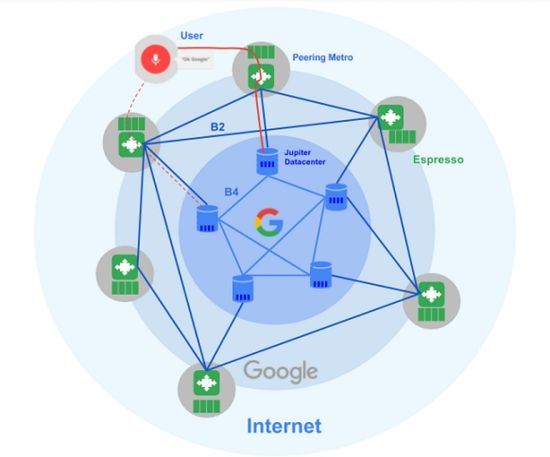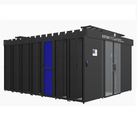Espresso, New SDN Technology of Google

Google has introduced a new software defined networking (SDN) strategy called "espresso".
It's a networking edge architecture that accounts for 20% of Google's total traffic over the past two years.
On April 4, Google engineer Aminhardt unveiled the "Google Espresso" architecture at the Open Networking Summit keynote address.
Google espresso is a peering edge architecture that is now applied to the network infrastructure of Google's cloud. It has been applied for more than two years and it is said that it is digging more than 20% of the total traffic.
Amin Bhardt explained the need for 'espresso' technology, as an example of real-time voice search. According to him, the Google assistant needs a quick and immediate connection to the question 'what is the latest news?' Your device is attached to the end of Google's network and connected to one of the Google data centers via Network Edge. Hundreds and thousands of individual servers in a data center will find audio phrases that compares and compares with numerous languages and dialects. The resulting phrase goes to another cluster and searches the Internet content through the web search as a real-time index. After the results are gathered, the best response is returned to the end user through the Google Network.

According to Admin Bhadat, "There are dozens of Internet routers in place to handle one query in real time, and thousands of computers around the world are mobilized," said Aminhardt. "It often has to be done in less than a second, and the answer system can handle thousands of new questions per second. It should be scalable so that we can do it. " Google believes that it is difficult to build a network infrastructure to meet these needs. For over ten years, it was the main reason for creating its own network infrastructure.
Google's design philosophy is that the network must be reliable in large distributed systems and through the same control infrastructure developed for Google's compute and storage systems.
Google has shared its SDN strategy with the outside world three times. The first is Jupiter, based on Google's SDN principles. Jupiter is a technology that interconnects more than 100,000 servers in a data center and provides one petabyte (Pbps) bandwidth per second.
And the B4 technology came out. B4 is a technology that connects multiple data centers to place replicated data in real time on multiple infrastructures and access them from anywhere in the world.
Google has shared its SDN strategy with the outside world three times. The first is Jupiter, based on Google's SDN principles. Jupiter is a technology that interconnects more than 100,000 servers in a data center and provides one petabyte (Pbps) bandwidth per second. And the B4 technology came out. B4 is a technology that connects multiple data centers to place replicated data in real time on multiple infrastructures and access them from anywhere in the world.Next up is the Network Functional Virtualization (NFV) technology, Andromeda. Andromeda allows Google's native applications to be stored in containers and virtual machines on the Google Crawl platform.
Espresso is the fourth axis of Google's SDN. Espresso technology performs two key innovations.
First, it does not provide fixed service to individual users according to static IP address, but dynamically provides service through the fastest infrastructure. Dynamically change the infrastructure that extinguishes traffic even if traffic is concentrated in one area.
"Espresso provides a way to manage performance and availability that is not possible with existing router-centric Internet protocols," said Amin Bhardt.
Espresso's second innovation is to separate and separate traffic management logic and controls from individual router boxes. Rather than relying on thousands of individual routers to manage and learn packet flows, we push them to a distributed system that extracts aggregate information. It learns how each flow happens through the signals of the large computing infrastructure and the application itself.
First, it does not provide fixed service to individual users according to static IP address, but dynamically provides service through the fastest infrastructure. Dynamically change the infrastructure that extinguishes traffic even if traffic is concentrated in one area. "Espresso provides a way to manage performance and availability that is not possible with existing router-centric Internet protocols," said Aminhardt. Espresso's second innovation is to separate and separate traffic management logic and controls from individual router boxes. Rather than relying on thousands of individual routers to manage and learn packet flows, we push them to a distributed system that extracts aggregate information. It learns how each flow happens through the signals of the large computing infrastructure and the application itself."Our network is a core part of our infrastructure," said Amin Bhardt. "Our network will continue to be a key opportunity and we will differentiate Google."
















